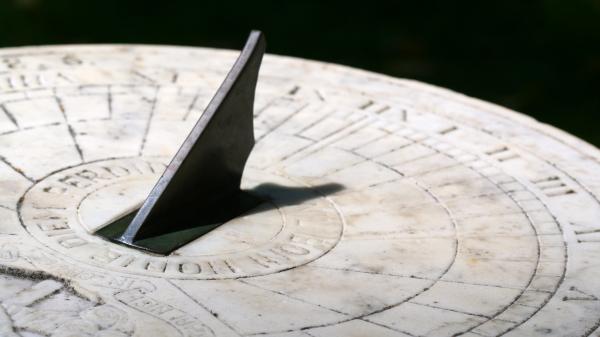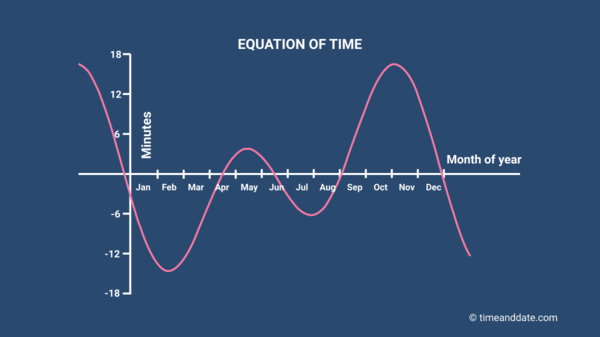Why Isn't the Year's Earliest Sunset on the Winter Solstice?
The winter solstice occurs around December 21 in the Northern Hemisphere and June 21 in the Southern Hemisphere.

Apparent solar time or true solar time is measured using a sundial.
©iStockphoto.com/hawkdvm
The moments when 99% of people see sunlight
Winter solstice is the shortest day of the year in terms of daylight, but it does not have the latest sunrise nor the earliest sunset of the year.
This is because of a discrepancy between our modern-day timekeeping methods and how time is measured using the Sun, known as the equation of time.
Earliest Sunset a Few Days Before
If you look at the sunrise and sunset times for any city in the Northern Hemisphere around the December Solstice, you will notice that the earliest sunset occurs a few days before the solstice and the latest sunrise happens a few days after the solstice.
This is also true for locations in the the Southern Hemisphere. There, the year's earliest sunset happens a few days before, and the year's latest sunrise occurs a few days after the winter solstice in June.
What are equinoxes and solstices?
Comparing Cities
Let’s take the example of New York City in the Northern Hemisphere and Sydney in the Southern Hemisphere. As you can see in the table, the latest sunrises and the earliest sunsets in the two cities do not occur on the day of the winter solstice.
| City | Winter Solstice Date | Latest Sunrise Date | Earliest Sunset Date |
|---|---|---|---|
| New York (40°43' North) | December 21, 2024 04:20 (4:20 am) EST | January 3 and 4, 2025 07:20 (7:20 am) EST | December 7, 2024 16:28 (4:28 pm) EST |
| Sydney (33°8' South) | June 21, 2024 06:50 (6:50 am) AEST | June 29 and 30, 2024 07:01 (7:01 am) AEST | June 11 and 12, 2024 16:52 (4:52 pm) AEST |
This can be explained by two factors: the equation of time and a location's latitude.
Equation of Time = Apparent Solar Time – Mean Solar Time
The equation of time is the difference between time measured using a sundial, also known as true or apparent solar time, and time measured using a clock, also known as mean solar time. It is often pictorially represented by a figure 8, which is called an analemma.
Most clocks run on the idea that a day is exactly 24 hours. Technically, a day is the duration between one solar noon, the time of the day when the Sun is at the highest point in the sky, to the next.
Read more about the equation of time


The varying speed of apparent or true solar time compared to mean solar time during the year.
Not Exactly 24 Hours Long
The length of a solar day, as this duration is called, is not exactly 24 hours long. It varies throughout the year because of the elliptical shape of Earth's orbit and its axial tilt. It is longer than 24 hours around the summer and winter solstices and shorter than 24 hours around the spring (vernal) and fall (autumnal) equinoxes.
On most days, solar noon does not occur at the same time as noon on your watch. Around the solstices, solar noon occurs a few minutes later than the previous day. For example, on December 21, 2024—the day of the Northern Hemisphere winter solstice—solar noon in New York is at 11:54 (11:54 am) EST. On January 3, 2025, the day of the latest sunrise, solar noon takes place 6 minutes later, at 12:00 Noon EST. The following day, January 4, solar noon falls at 12:01 EST, and keeps getting later throughout January.
As solar noons increasingly occur later, sunrises and sunsets also steadily occur later each day after the winter solstice. This is why a location's earliest sunset occurs before, and its latest sunrise occurs after the winter solstice.
Latitude Matters
The dates for the earliest sunset and latest sunrise for a location also depend on its latitude. Locations closer to the equator have their earliest sunset sometime in November. Locations at higher latitudes, on the other hand, have their earliest sunset later, closer to the actual date of the winter solstice.
This occurs because of the Sun’s declination, which is the angle at which the rays of the Sun hit the plane of Earth’s Equator.
Because Earth’s rotational axis is tilted to about 23.4 degrees, the Sun’s declination varies through the year. During the summer solstice, it is +23.4 degrees and during the winter solstice, it is -23.4 degrees. It is 0 degrees during the equinoxes.
When the solar declination is +23.4 degrees, all locations in the Northern Hemisphere experience over 12 hours of daylight, while all locations in the Southern Hemisphere experience less than 12 hours of daylight. This effect reverses when the Sun’s declination is -23.4 degrees.
During the equinoxes, when the Sun’s declination is 0 degrees, most locations on Earth, with the exception of locations on and around the poles, experience around 12 hours of sunlight.